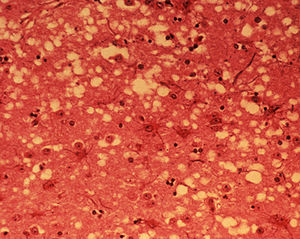 |
| Image via Wikipedia |
Numbers still low; no known threat to humans or livestock
PRATT — The number of cases of chronic wasting disease (CWD) detected in Kansas deer continues to be low and is currently isolated to the northwest part of the state, according to the Shane Hesting, wildlife disease coordinator for the Kansas Department of Wildlife, Parks and Tourism (KDWPT). Samples from three white-tailed bucks taken during this year’s hunting season were confirmed positive for CWD in tests completed last week. Counties where the deer were taken include Wallace (new county of detection), Decatur, and Rawlins. KDWPT will continue testing some vehicle-killed and sick or suspect-looking deer, as well as deer taken with depredation permits, through July 31.
PRATT — The number of cases of chronic wasting disease (CWD) detected in Kansas deer continues to be low and is currently isolated to the northwest part of the state, according to the Shane Hesting, wildlife disease coordinator for the Kansas Department of Wildlife, Parks and Tourism (KDWPT). Samples from three white-tailed bucks taken during this year’s hunting season were confirmed positive for CWD in tests completed last week. Counties where the deer were taken include Wallace (new county of detection), Decatur, and Rawlins. KDWPT will continue testing some vehicle-killed and sick or suspect-looking deer, as well as deer taken with depredation permits, through July 31.
“This season’s testing results bring the total number of confirmed CWD cases in Kansas to 43 since testing began in 1996,” says Hesting. “About 2,400 samples were collected during the 2011-2012 deer seasons, but testing has been slow, and testing kits are continually on back order. We’re about 35 percent done. More importantly, U.S. Department of Agriculture funding will not be available for collecting and testing samples next season. Without federal financial assistance, surveillance will be very limited and less robust.”
Annual testing has been a part of an ongoing effort by KDWPT to monitor the prevalence and spread of CWD. The disease, fatal in wild deer, was first detected in deer taken in Cheyenne County in 2005.
CWD is a member of the group of diseases called transmissible spongiform encephalopathies (TSEs). Other diseases in this group include scrapie in sheep and goats, bovine spongiform encephalopathy (BSE or Mad Cow Disease) in cattle, and Cruetzfeldt-Jakob disease in people. CWD is a progressive, fatal disease that results in small holes developing in the brain, giving it a sponge-like appearance under the microscope. An animal may carry the disease without outward indication, but in the later stages, signs may include decreased interactions with other animals, listlessness, lowering of the head, weight loss, repetitive walking in set patterns, and a lack of response to humans.
“It must be noted that many of the symptoms of CWD are indicative of other diseases,” Hesting explains. “Thus, a sick deer may or may not be infected with CWD. CWD is a serious deer disease but is still rare in Kansas.”
All but three of the 43 positive animals detected since 2005 were asymptomatic, meaning 40 animals did not show any symptoms of CWD at the time of collection. Anyone who discovers a sick or suspect deer should contact the nearest KDWP office.
There is no vaccine or other biological method that prevents CWD. However, there is no evidence that CWD poses a risk to humans or livestock in the natural environment. Still, precautions should be taken. Hunters are advised not to eat meat from animals known to be infected, and common sense precautions are advised when field dressing and processing meat from animals taken in areas where CWD is found. More information on CWD can be found on KDWPT’s website, www.ksoutdoors.com(Hunting/Big Game Information), or at the Chronic Wasting Disease Alliance website,www.cwd-info.org.


No comments:
Post a Comment